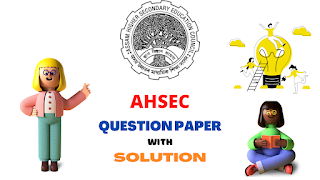ASSEB| CLASS 12| LOGIC AND PHILOSOPHY| SOLVED PAPER - 2025| H.S. 2ND YEAR
2025
LOGIC AND
PHILOSOPHY
(Theory)
Full Marks:
100
Pass Marks:
30
Time: Three
hours
The figures
in the margin indicate full marks for the questions.
1. Give very short answers: (any twelve) 1x12=12
(a) What is the ideal of Logic?
Ans:- Attainment
of truth.
(b) ‘The conclusion of unscientific
induction is certain’ – Is it true?
Ans:- No,
it is false.
(c) Does Analogy depend on the Law
of Causation?
Ans:- No.
(d) ‘The ground of Induction is the
result of induction’ – Who made this statement?
Ans:- J.S.
Mill.
(e) Are non-voluntary actions
regarded as objects of moral judgement?
Ans:- No.
(f) Name the theory which states
that the external world can be directly known.
Ans:- Naïve
realism (direct realism).
(g) ‘Electricity is a fluid’ – What
type of hypothesis is this?
Ans:- Imaginative
hypothesis.
(h) What, according to Indian
Philosophy, is the Supreme and Ultimate end of human life?
Ans:- Moksha.
(i) ‘Primary qualities are the
necessary properties of an object’- Is it true?
Ans:- Yes.
(j) What does the external aspect of
Religion refer to?
Ans:- Rituals
and ceremonies.
(k) ‘Ethics is a positive science’ –
Is it true?
Ans:- No.
(l) On which canon of elimination is
the Method of Agreement established?
Ans:- The
principle of consensus.
(m) What is the third stage of
hypothesis?
Ans:- Verification.
(n) Does the Method of Difference
yield a certain conclusion?
Ans:- Yes.
2. What
do you mean by ‘Induction proper’? 2
Ans:- Real induction refers to the
process of establishing a general true proposition based on the observation of
specific instances, relying on the uniformity of nature and the law of
causality. It attempts to make universal claims from specific observations.
Or
Why is the conclusion of Scientific
Induction certain? 2
Ans:- The conclusion of scientific induction is
considered certain because it is based on the law of causality, which states
that every event must have a cause. Scientific induction relies on this very
principle, giving its conclusions the highest value of certainty.
3. Give an
example of ‘Plurality of Causes’ 2
Ans:- An example of plurality of causes
is how a fire can be caused by different factors such as a short circuit, a
burning match, a lightning strike, or friction. Each factor represents a
different possible cause leading to the same effect.
Or
Give an example of positive
condition. 2
Ans:- A positive condition is a factor that must be
present for an effect to occur. For example, the presence of oxygen is a
positive condition for combustion—without oxygen, fire cannot occur.
4.
Mention any two characteristics of experiment. 2
Ans:-
Two characteristics of an experiment are:-
(i) Controlled conditions: Experiments are conducted by
controlling variables to isolate the effect of the factor being tested.
(ii) Repetition: Experiments can be repeated under
the same conditions to confirm the results.
5. Give
a concrete example of the Method of Residues. 2
Ans:- Suppose a person consumes a mixture
of A, B, and C. If the effects X and Y are known and result from A and B, and a
new effect Z is observed, then by the residual method, the effect Z is
attributed to C.
6. Why
is the Idealism of Leibnitz called Pluralistic Idealism? 2
Ans:- Leibniz's idealism is called
pluralistic because he proposed that reality is composed of innumerable
individual spiritual substances called monads, rather than a single
substance—hence, his idealism recognizes a plurality of independent entities.
Or
Write any two characteristics of
Objective Idealism. 2
Ans:- Two characteristics of
objective idealism are:-
(i) Reality is essentially mental: According to objective idealism,
ultimate reality is spiritual or mental, but it exists independently of
individual minds.
(ii) Universal mind: Reality is often viewed as an
expression of an absolute or universal mind rather than merely a subjective
experience.
7. What
do you mean by ‘moral obligation’? 2
Ans:- Moral obligation is the duty or
responsibility to act in accordance with moral principles, regardless of one's
personal interests or desires.
Or
What is Voluntary action? 2
Ans:- Voluntary action, unlike involuntary or
reflexive actions, is a purposeful action performed with knowledge, intention,
and free will.
8. Write
two characteristics of Naive Realism. 2
Ans:-
Two characteristics of naïve realism are:-
(i) Direct perception: Naïve realism believes that objects
are directly perceived as they are, without any mediation or distortion.
(ii) Independence of perception: It asserts that physical objects
exist independently of perception.
9.
Mention any two conditions of a valid hypothesis. 2
Ans:-
Two conditions of a valid hypothesis are:-
(i) Testability: A valid hypothesis should be
testable or verifiable by observation or experiment.
(ii) Consistency: It should not conflict with
established facts or known theories.
10. Who
is regarded as the Father of Modern Philosophy? What is his famous saying?
1+1=2
Ans:- René Descartes is considered the
father of modern philosophy. His famous quote is "Cogito, ergo sum"
(I think, therefore I am).
11. What is
Secondary Quality? Give an example. 1+1=2
(Buy E-Books to read complete solutions)
DOWNLOAD [PAGE LINK:-CLICK HERE]
***
LOGIC AND PHILOSOPHY SOLVED PAPERS PAGE LINK - Click here
BUY E-BOOK (PDF FILE)
[TO SEE FULL SOLUTION]
(Chapter wise Notes, Exam Question Papers solved, MCQ solved) [ARTS, COMMERCE, SCIENCE]
|
DOWNLOAD PAGE LINK:-CLICK HERE |
ASSEB/ AHSEC PAGE LINK - CLICK HERE

